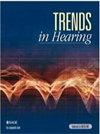On the Feasibility of Using Behavioral Listening Effort Test Methods to Evaluate Auditory Performance in Cochlear Implant Users
IF 3
2区 医学
Q1 AUDIOLOGY & SPEECH-LANGUAGE PATHOLOGY
引用次数: 0
Abstract
Realistic outcome measures that reflect everyday hearing challenges are needed to assess hearing aid and cochlear implant (CI) fitting. Literature suggests that listening effort measures may be more sensitive to differences between hearing-device settings than established speech intelligibility measures when speech intelligibility is near maximum. Which method provides the most effective measurement of listening effort for this purpose is currently unclear. This study aimed to investigate the feasibility of two tests for measuring changes in listening effort in CI users due to signal-to-noise ratio (SNR) differences, as would arise from different hearing-device settings. By comparing the effect size of SNR differences on listening effort measures with test–retest differences, the study evaluated the suitability of these tests for clinical use. Nineteen CI users underwent two listening effort tests at two SNRs (+4 and +8 dB relative to individuals’ 50% speech perception threshold). We employed dual-task paradigms—a sentence-final word identification and recall test (SWIRT) and a sentence verification test (SVT)—to assess listening effort at these two SNRs. Our results show a significant difference in listening effort between the SNRs for both test methods, although the effect size was comparable to the test–retest difference, and the sensitivity was not superior to speech intelligibility measures. Thus, the implementations of SVT and SWIRT used in this study are not suitable for clinical use to measure listening effort differences of this magnitude in individual CI users. However, they can be used in research involving CI users to analyze group data.使用行为听力努力测试方法评估人工耳蜗使用者听力表现的可行性
在评估助听器和人工耳蜗(CI)验配时,需要能反映日常听力挑战的真实结果测量。文献表明,当言语清晰度接近最大值时,听力努力测量法可能比既定的言语清晰度测量法对听力设备设置之间的差异更加敏感。目前还不清楚哪种方法能最有效地测量听力强度。本研究旨在调查两种测试方法的可行性,以测量 CI 用户因不同听力设备设置造成的信噪比(SNR)差异而引起的聆听强度变化。通过比较信噪比差异对听力测量的影响大小和测试-再测试差异,该研究评估了这些测试在临床应用中的适用性。19 名 CI 用户在两种信噪比(相对于个人 50%言语感知阈值的 +4 和 +8 dB)下进行了两次听力努力测试。我们采用了双任务范式--句子末尾单词识别和回忆测试 (SWIRT) 和句子验证测试 (SVT)--来评估这两种信噪比下的听力强度。我们的结果表明,两种测试方法在不同信噪比下的听力努力程度存在显著差异,但其效应大小与测试-重复差异相当,灵敏度也不优于语音清晰度测量。因此,本研究中使用的 SVT 和 SWIRT 不适合在临床上用于测量 CI 用户听力差异。不过,它们可用于涉及 CI 用户的研究,以分析群体数据。
本文章由计算机程序翻译,如有差异,请以英文原文为准。
求助全文
约1分钟内获得全文
求助全文
来源期刊

Trends in Hearing
AUDIOLOGY & SPEECH-LANGUAGE PATHOLOGYOTORH-OTORHINOLARYNGOLOGY
CiteScore
4.50
自引率
11.10%
发文量
44
审稿时长
12 weeks
期刊介绍:
Trends in Hearing is an open access journal completely dedicated to publishing original research and reviews focusing on human hearing, hearing loss, hearing aids, auditory implants, and aural rehabilitation. Under its former name, Trends in Amplification, the journal established itself as a forum for concise explorations of all areas of translational hearing research by leaders in the field. Trends in Hearing has now expanded its focus to include original research articles, with the goal of becoming the premier venue for research related to human hearing and hearing loss.
 求助内容:
求助内容: 应助结果提醒方式:
应助结果提醒方式:


